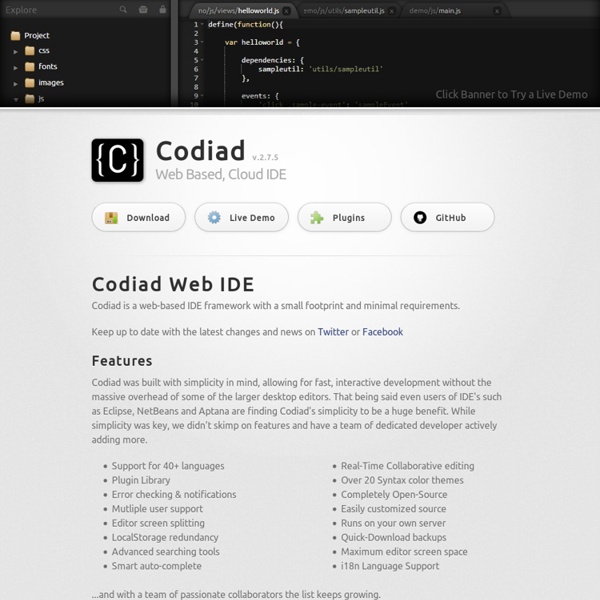Codiad Web Based IDE by Fluidbyte
Codiad is a web-based IDE framework with a small footprint and minimal requirements. Keep up to date with the latest changes and news on Twitter or Facebook Features Codiad was built with simplicity in mind, allowing for fast, interactive development without the massive overhead of some of the larger desktop editors. That being said even users of IDE's such as Eclipse, NetBeans and Aptana are finding Codiad's simplicity to be a huge benefit. While simplicity was key, we didn't skimp on features and have a team of dedicated developer actively adding more.
http://codiad.com/
Related: ÉDITEURS DE CODE et IDE
HTMLPad - Product line
Rapid CSS Editor Buy Now from $29.95 More Info Lightweight HTML and CSS editor for designers who work with CSS and HTML most of the time and do not do script programming. HTMLPad
The Definitive Guide: Sublime Text 2, a Code Editor to Love
You know, old habits die hard. Therefore I got stuck to the HTML editor Homesite ever since I started to design websites more than a century ago. I took a look at other editors here and there but always returned to my good ol’ buddy. It had almost everything I needed on my daily business. Okay, it lacked movable tabs, the file browser was pretty sluggish and some other minor glitches bugged me from time to time. But I loved it wholeheartedly.
alertify.js - browser dialogs never looked so good
Unfortunately, I will no longer be maintaining alertify.js. I have many ongoing projects that aren't leaving me with enough time to do what needs to be done. If anyone wants to create a fork and maintain - by all means go for it! It's been great seeing people use it and enjoy it and this decision is simply because I don't believe it's fair that developers are looking for help and not getting it. I wish I had more time or contributions to keep it going and make it better, but the sad reality is that not usually the case on these kinds of projects. Forks
Tuto Ninja Authoring Tool
Modern HTML rendering engines and emerging standards make it possible to create a new class of rich experiences that could previously be achieved only with native development toolkits—but developers need better Web development frameworks and authoring tools in order to take advantage of the possibilities. Three new open-source software projects developed at Motorola Mobility hope to address the problem. We—Tim Statler, Zachary Cohen, and Kris Kowal—have had the pleasure of working on a new content creation tool called Ninja, a JavaScript development framework called Montage, and a testing automation tool called Screening. In this article, we will describe all three pieces of software, and we've included code examples to illustrate some of the functionality. But first—a high-level overview. The Ninja authoring tool is a Google Chrome app for designing keyframe-based animation with HTML5, including 3D scenes and vector graphics.
Development Environments - Full Stack Python
A development environment is a combination of a text editor and the Python interpreter. The text editor allows you to write the code. The interpreter provides a way to execute the code you've written. A text editor can be as simple as Notepad on Windows or more complicated as a complete integrated development environment (IDE) such as PyCharm which runs on any major operating system. Why is a development environment necessary? Python code needs to be written, executed and tested to build applications.
Gozala/sky-edit
SweetAlert
A beautiful replacement for Javascript's "Alert" So... What does it do? Here’s a comparison of a standard error message.
cssdeck codecasts by quanta
Revealing CSSDeck Codecasts Website: Twitter: @cssdeck what? You must have seen tons of stuff around the web like:
ajaxorg/cloud9
InK - Interface Kit
JSbin, JSfiddle or Codepen, which one to use and why?
There are lots of css – js playgrounds now in the market, and the most popular ones are JSbin (by Remy Sharp), JSfiddle (by Oskar Krawczyk), codepen (by Chris Coyier, Tim Sabat and Alex Vasquez). So sometimes it become a confusing question which one to use; and more importantly why and when? Let’s compare these three today and find out which one can be the most suitable one for you. So, first of all let’s compare the features of these three.
ACE - The High Performance Code Editor for the Web
13 Cloud IDEs For Web Developers - Hongkiat
With so much of the traditional, desktop-based productivity software we know and love moving to the Cloud, it’s no surprise that Cloud-based IDEs are quickly gaining ground with developers. Nowadays, the browser is essentially a thin client that allows users to access a variety of Cloud-based applications and services. However, many are still hesitant to put their full faith in a remote Cloud IDE for development purposes. Tools like Github and Pastebin helped to ease the transition to Cloud-based development, and full-fledged Cloud IDEs are now commonly used by many developers. Here are 13 of the best Cloud IDEs you can get your hands on and a quick summation of each. Cloud9
Related:


